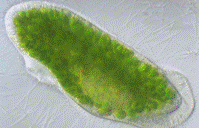Biological Sciences, School of

School of Biological Sciences: Faculty Publications
Document Type
Article
Date of this Version
1980
Abstract
Second thoracic mammary glands of immature BALB/c female mice were stimulated to pregnancy-like lobuloalveolar (LA) development after 6 days of incubation in a corticosteroid-free step I culture medium containing insulin, prolactin, estradiol, progesterone, and growth hormone. A low basal level (0.0009%) of casein mRNA (mRNAcsn) sequences was detectable in the LA glands by a specific cDNA probe. Subsequent incubation of the LA glands for 3 days in medium containing insulin and prolactin or insulin and cortisol failed to elicit mRNAcsn above the basal level, indicating that neither prolactin nor cortisol alone can support casein gene expression. However, an increase in mRNA. levels was observed when the 3-day incubation with insulin and cortisol or insulin and prolactin was followed by 3 days of culture in presence of insulin, prolactin, and cortisol. When a 3-day incubation with insulin and prolactin was followed by 3 days in insulin and cortisol medium, mRNAcsn. levels in the gland remained similar to the basal level. However, a 20-fold increase in the mRNAcsn levels ensued when the LA glands were sequentially incubated for 3 days in insulin and cortisol and then for another 3 days in insulin and prolactin medium. After a preincubation in insulin and cortisol medium, the LA glands retained residual cortisol during subsequent incubation in insulin and prolactin medium, and the mRNAcsn. levels in these glands were related to the level of residual cortisol present. When mRNAcsn and the residual cortisol level reached a minimum, addition of fresh cortisol to the medium caused a 20-fold increase in the mRNAcsn levels. This indicates that cortisol is a limiting factor in insulin and prolactin medium and its presence is absolutely required for casein gene expression.


Comments
Published in Proc. Natl. Acad. Sci. USA Vol. 77, No. 10, pp. 6003-6006, October 1980